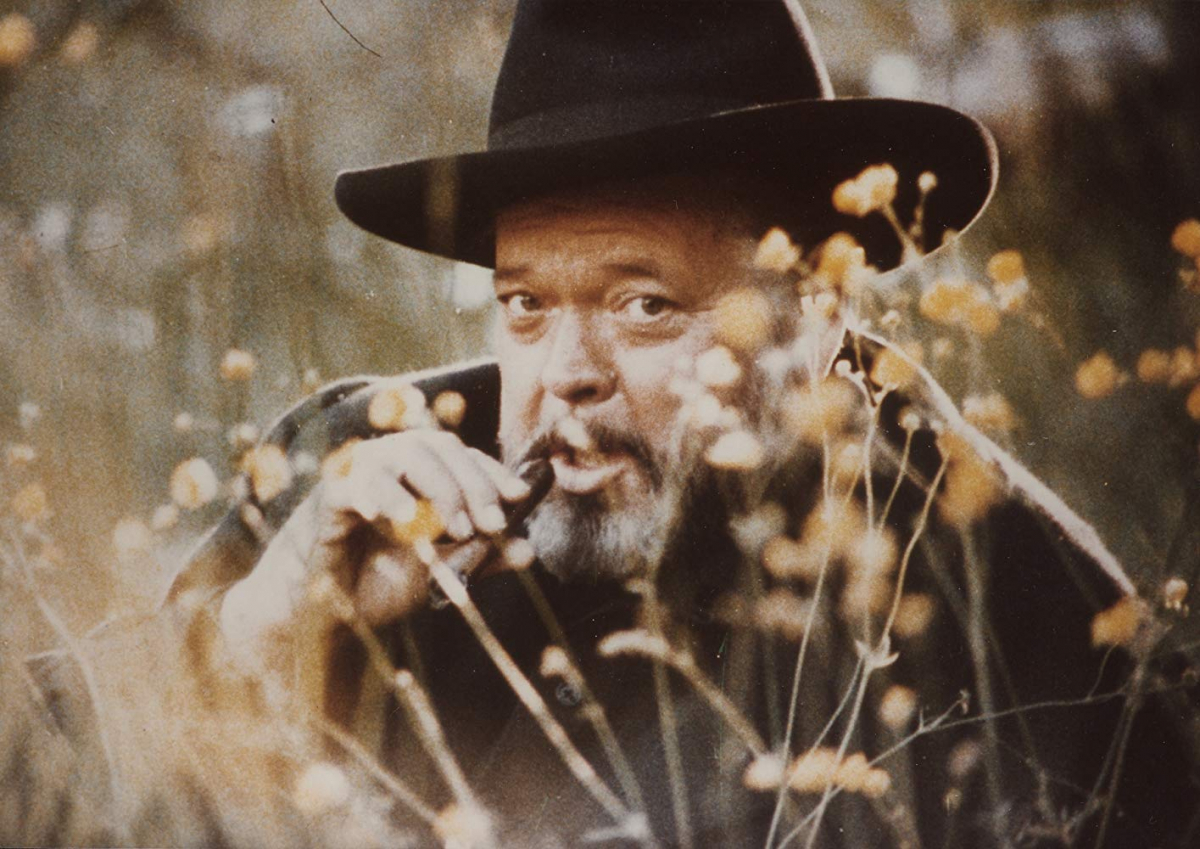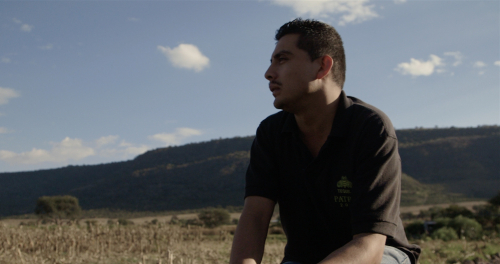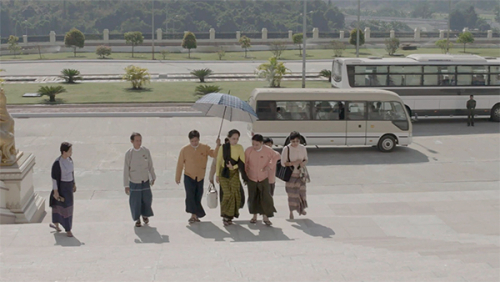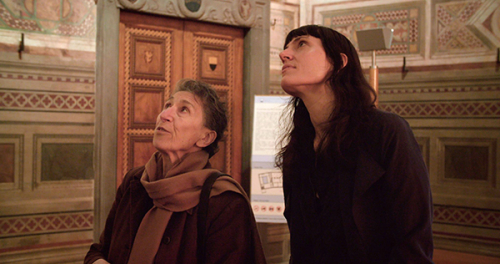Archive
FACT OR FAKE: Truth On Film
F for Fake
Director
Orson Welles
Producer
François Reichenbach
Cinematographer
François Reichenbach
Editors
Dominique Engerer
Marie-Sophie Dubus
Sound
Paul Bertault





1973
France, Iran, Germany
29 min
Color
Now considered to be one of the greatest documentaries of all time, writer and director Orson Welles joyously weaves the extraordinary story of art faker Elmyr de Hory and his biographer, Clifford Irving, who faked a memoir of reclusive tycoon Howard Hughes. As Welles brilliantly cuts between these two entertaining stories, he offers up a delightful running commentary about art forgery, Picasso, Swiss checks, the movies and our very existence. The essay's final ten minutes, a meditation on the enormous Chartes cathedral built by unknown craftsmen, is both profound and majestic. Perhaps no film has come close to matching the sheer bravura of this last competed masterpiece of Orson Welles, the cinema's most imaginative magician.
GO ON SINGING: ORSON WELLES AND F FOR FAKE
by Thomas Logoreci
For this edition of DokuFest, we will be screening a high quality remastering of writer and director Orson Welles essay documentary, F for Fake (1973). Even though I have watched this doc many, many times, I’ve never seen this masterwork in a theater so I’m certain the Prizren show will be a special and memorable one.
It’s unfortunate but the first time I saw F for Fake (1973) was on a moldy and waterlogged VHS cassette. I’d found this cassette treasure in an empty cardboard box, left out on the sidewalk with the trash, late one night in San Francisco, California in 2001.
I had come up to the Bay Area after finishing film school in Los Angeles. Initially, I hadn’t been very successful in finding a job or place to live. Found footage filmmaker Jay Rosenblatt had given me the unpaid task of going through thousands of cans of home movies in his basement storage facility. Since Jay had also given me the keys and was four floors up, I’d taken to sleeping there too.
Jay was working on a film about grief so I spent countless hours spooling through reel after reel, taking out selects bits of film that brought up associations of mourning or sadness. After a particularly lengthy session of this work, I went out to get some beer before the liquor stores closed at two in the morning. If you’re willing to stop and look, San Francisco is rich in boxes of books, records, furniture and clothes left on the street. With my beer in hand, I turned a corner, opened one of these abandoned boxes and came upon the tape of F for Fake.
I recall being disappointed as I stood there, looking at the somewhat tacky cover art design, a bearded Orson Welles, dressed in black, his eyes duplicated four times. I had read a little about the film since I was a teenager, mostly in movie encyclopedia’s and a biography or two. Many of these authors and critics had dismissed F for Fake as the minor work of the middle-aged Welles, the former child genius who had once conquered the film world at age 26 with his history-making debut, Citizen Kane.
Of course, like any self-respecting movie nerd, I worshipped Citizen Kane. But the Welles films I most obsessed about were Kane’s massacred follow-up, The Magnificent Ambersons (1942) and his baroque noir Touch of Evil (1958), which featured a startling performance by Orson as a bloated, corrupt police captain. I’d watched and re-watched these two films. In the case of Touch of Evil, I knew virtually every one of the film’s effortlessly gliding camera moves and could recite each line of dialogue even if the sound was off. Yet I’d had no curiosity to delve into Welles F for Fake.
Returning to Jay’s basement studio, I wiped the dirty cassette off and popped it into the player. By the time I reached the end of the film’s ninety-nine minutes, I was convinced of two things. That I had been a snobby fool for ignoring F for Fake and that Welles had crafted an infinitely more complex and moving testament to art, the cinema and our very existence than any film he had done before.
F for Fake is a thrilling roller coaster ride through the weirdly complex chronicle of Clifford Irving, the author of a book about art faker Elmyr de Hory who ended up faking another book, the life story of the reclusive billionaire Howard Hughes.
But the heart of the thrill comes not from the ingenuity of a lone, brooding auteur but the varied assortment of people Welles collaborated with on the project. Welles seamlessly utilizes footage shot by French filmmaker Francois Reichenbach then melds this leftover material with film shot by his collaborator Gary Graver. Most of all, it was the tremendous influence of his Croat partner and lover, Oja Kadar, who was responsible for much of F for Fake’s playful and sensuous flavor.
However, F for Fake was not the passion project that consumed Orson Welles in the 1970’s. Neville Morgan’s recently acclaimed doc, They’ll Love Me When I’m Dead, revealed that honor went to the still-unfinished The Other Side of the Wind, an elaborate fiction puzzle centered on a film within a film. The Other Side of the Wind drained most of Welles energy and money until his death in 1985.
Orson also suffered terrible agony after the powerful New Yorker critic, Pauline Kael, who in 1971 wrote a two part article that alleged Welles had little or nothing to do with the screenplay of his most famous film, Citizen Kane. Rather than shrink from these arrows, Orson Welles tackled painful questions of authorship, mortality and the permanence of all things in the finale of F for Fake. In his famous butterscotch voice, Welles narrator regards the splendor of France’s towering Chartes cathedral, a 12th century work of art designed and built by anonymous hands.
Over an image of the great church, Orson’s voice-over tells us, “Our works in stone, in paint, in print, are spared, some of them for a few decades or a millennium or two, but everything must finally fall in war or wear away into the ultimate and universal ash. A fact of life. We’re going to die. ‘Be of good heart,’ cry the dead artists out of the living past. Our songs will be silenced — but what of it? Go on singing.” Tragically, Orson Welles did not. Though he reveled in the notion of producing many more essay documentaries in the time that remained, F for Fake would be his last film.
It would not have been possible for young Orson to craft a film as deeply profound and purely metaphysical as F for Fake. Around the time he was making this documentary, Oja Kodar recalls peeking into the living room and seeing Orson watching on television his torn and amputated The Magnificent Ambersons. Welles put his head in his hands and begin crying.
Perhaps to achieve the shattering depth and clarity of vision F for Fake required, Orson Welles needed the thirty years of humiliation, disappointment, the pile of unfinished projects, the weary tears of regret. The cinema and DokuFest are all the richer for it.
GO ON SINGING: ORSON WELLES AND F FOR FAKE
by Thomas Logoreci
For this edition of DokuFest, we will be screening a high quality remastering of writer and director Orson Welles essay documentary, F for Fake (1973). Even though I have watched this doc many, many times, I’ve never seen this masterwork in a theater so I’m certain the Prizren show will be a special and memorable one.
It’s unfortunate but the first time I saw F for Fake (1973) was on a moldy and waterlogged VHS cassette. I’d found this cassette treasure in an empty cardboard box, left out on the sidewalk with the trash, late one night in San Francisco, California in 2001.
I had come up to the Bay Area after finishing film school in Los Angeles. Initially, I hadn’t been very successful in finding a job or place to live. Found footage filmmaker Jay Rosenblatt had given me the unpaid task of going through thousands of cans of home movies in his basement storage facility. Since Jay had also given me the keys and was four floors up, I’d taken to sleeping there too.
Jay was working on a film about grief so I spent countless hours spooling through reel after reel, taking out selects bits of film that brought up associations of mourning or sadness. After a particularly lengthy session of this work, I went out to get some beer before the liquor stores closed at two in the morning. If you’re willing to stop and look, San Francisco is rich in boxes of books, records, furniture and clothes left on the street. With my beer in hand, I turned a corner, opened one of these abandoned boxes and came upon the tape of F for Fake.
I recall being disappointed as I stood there, looking at the somewhat tacky cover art design, a bearded Orson Welles, dressed in black, his eyes duplicated four times. I had read a little about the film since I was a teenager, mostly in movie encyclopedia’s and a biography or two. Many of these authors and critics had dismissed F for Fake as the minor work of the middle-aged Welles, the former child genius who had once conquered the film world at age 26 with his history-making debut, Citizen Kane.
Of course, like any self-respecting movie nerd, I worshipped Citizen Kane. But the Welles films I most obsessed about were Kane’s massacred follow-up, The Magnificent Ambersons (1942) and his baroque noir Touch of Evil (1958), which featured a startling performance by Orson as a bloated, corrupt police captain. I’d watched and re-watched these two films. In the case of Touch of Evil, I knew virtually every one of the film’s effortlessly gliding camera moves and could recite each line of dialogue even if the sound was off. Yet I’d had no curiosity to delve into Welles F for Fake.
Returning to Jay’s basement studio, I wiped the dirty cassette off and popped it into the player. By the time I reached the end of the film’s ninety-nine minutes, I was convinced of two things. That I had been a snobby fool for ignoring F for Fake and that Welles had crafted an infinitely more complex and moving testament to art, the cinema and our very existence than any film he had done before.
F for Fake is a thrilling roller coaster ride through the weirdly complex chronicle of Clifford Irving, the author of a book about art faker Elmyr de Hory who ended up faking another book, the life story of the reclusive billionaire Howard Hughes.
But the heart of the thrill comes not from the ingenuity of a lone, brooding auteur but the varied assortment of people Welles collaborated with on the project. Welles seamlessly utilizes footage shot by French filmmaker Francois Reichenbach then melds this leftover material with film shot by his collaborator Gary Graver. Most of all, it was the tremendous influence of his Croat partner and lover, Oja Kadar, who was responsible for much of F for Fake’s playful and sensuous flavor.
However, F for Fake was not the passion project that consumed Orson Welles in the 1970’s. Neville Morgan’s recently acclaimed doc, They’ll Love Me When I’m Dead, revealed that honor went to the still-unfinished The Other Side of the Wind, an elaborate fiction puzzle centered on a film within a film. The Other Side of the Wind drained most of Welles energy and money until his death in 1985.
Orson also suffered terrible agony after the powerful New Yorker critic, Pauline Kael, who in 1971 wrote a two part article that alleged Welles had little or nothing to do with the screenplay of his most famous film, Citizen Kane. Rather than shrink from these arrows, Orson Welles tackled painful questions of authorship, mortality and the permanence of all things in the finale of F for Fake. In his famous butterscotch voice, Welles narrator regards the splendor of France’s towering Chartes cathedral, a 12th century work of art designed and built by anonymous hands.
Over an image of the great church, Orson’s voice-over tells us, “Our works in stone, in paint, in print, are spared, some of them for a few decades or a millennium or two, but everything must finally fall in war or wear away into the ultimate and universal ash. A fact of life. We’re going to die. ‘Be of good heart,’ cry the dead artists out of the living past. Our songs will be silenced — but what of it? Go on singing.” Tragically, Orson Welles did not. Though he reveled in the notion of producing many more essay documentaries in the time that remained, F for Fake would be his last film.
It would not have been possible for young Orson to craft a film as deeply profound and purely metaphysical as F for Fake. Around the time he was making this documentary, Oja Kodar recalls peeking into the living room and seeing Orson watching on television his torn and amputated The Magnificent Ambersons. Welles put his head in his hands and begin crying.
Perhaps to achieve the shattering depth and clarity of vision F for Fake required, Orson Welles needed the thirty years of humiliation, disappointment, the pile of unfinished projects, the weary tears of regret. The cinema and DokuFest are all the richer for it.
Directors' Biography
Orson Welles wrote, directed and starred in the film 'Citizen Kane,' among others, which remains one of the most influential films ever made. Born on May 6, 1915, in Kenosha, Wisconsin, Orson Welles began his career as a stage actor before going on to radio, creating his unforgettable version of H.G. Wells's War of the Worlds. In film, he left his artistically indelible mark with such works as Citizen Kane and The Magnificent Ambersons. He died of a heart attack in Los Angeles, California, on October 10, 1985.
Other films in FACT OR FAKE: Truth On Film
Showtimes
No Showtimes










